In the field of medicine and public health, full form of AIDS (a well-known abbreviation) that stands for Acquired Immunodeficiency Syndrome. It is a serious and potentially life-threatening condition caused by the Human Immunodeficiency Virus (HIV). AIDS weakens the immune system, leaving the affected individual vulnerable to various infections and diseases. Since its identification in the early 1980s, AIDS has been a global health concern, prompting extensive research, awareness campaigns, and efforts to prevent its spread. In this comprehensive guide, we will explore the details of AIDS, its causes, symptoms, prevention, and its impact on global health.
What is AIDS?
Acquired Immunodeficiency Syndrome (AIDS) is the final stage of HIV infection. It occurs when the immune system of an individual is severely damaged by the HIV virus, and the body becomes vulnerable to opportunistic infections and certain cancers. AIDS is a condition that can be life-threatening if not managed with proper medical care.
Causes of AIDS
AIDS is caused by the Human Immunodeficiency Virus (HIV). HIV attacks and weakens the immune system by destroying CD4 cells, a type of white blood cell that plays a crucial role in fighting off infections. As the immune system becomes progressively compromised, the individual becomes susceptible to a range of illnesses that a healthy immune system would normally fend off.
Symptoms of AIDS
The symptoms of AIDS can vary but may include:
- Frequent Infections: Individuals with AIDS often experience frequent and severe infections, including pneumonia, tuberculosis, and fungal infections.
- Rapid Weight Loss: Unexplained and significant weight loss can occur.
- Chronic Diarrhea: Diarrhea that lasts for more than a month can be a symptom.
- Skin Rashes: Persistent skin problems, sores, or rashes may develop.
- Fatigue: Extreme tiredness and fatigue are common.
- Swollen Lymph Nodes: Swelling of lymph nodes that persists for an extended period.
- Fever and Night Sweats: Recurrent fevers and night sweats can be indicative.
It’s important to note that HIV infection can remain asymptomatic for several years before progressing to AIDS. Early detection and medical care can delay the onset of AIDS.
Also Read: Best online IELTS coaching & training academy
Prevention and Treatment – AIDS
Preventing HIV infection is crucial in averting AIDS. Effective prevention measures include:
- Safe Sex: Using condoms during sexual activity reduces the risk of HIV transmission.
- Needle Exchange Programs: For individuals who inject drugs, using sterile needles and syringes is essential.
- Pre-Exposure Prophylaxis (PrEP): PrEP medication is available for individuals at high risk of HIV infection.
- Post-Exposure Prophylaxis (PEP): PEP medication can be taken after potential exposure to HIV to prevent infection.
- Testing and Counseling: Regular HIV testing and counseling can help individuals know their status and make informed decisions.
Treatment for HIV involves antiretroviral therapy (ART), which can slow the progression of HIV infection and delay the onset of AIDS. ART helps control the virus, preserves the immune system, and reduces the risk of transmission.
Global Impact – AIDS
AIDS has had a significant global impact, with millions of people affected worldwide. Efforts to combat the epidemic include awareness campaigns, access to testing and treatment, and support for affected individuals and communities. The global response to AIDS has led to advancements in medical research, increased awareness, and improved access to care.
Conclusion
Acquired Immunodeficiency Syndrome (AIDS) is a serious medical condition caused by HIV infection. While it remains a global health challenge, significant progress has been made in understanding, preventing, and treating AIDS. Public awareness, early detection, safe practices, and access to medical care are vital components of the ongoing effort to combat AIDS and promote a healthier world.








